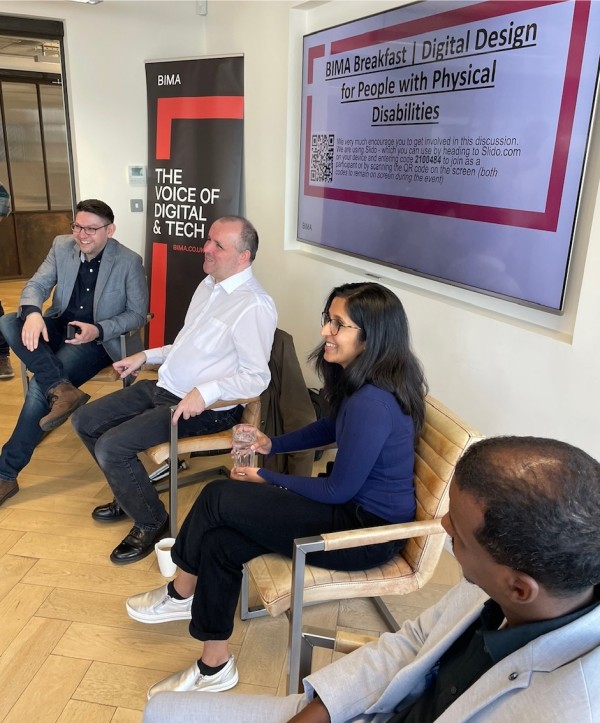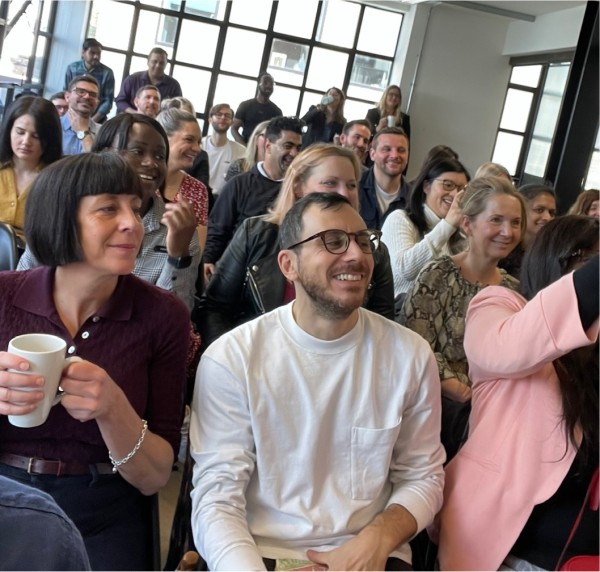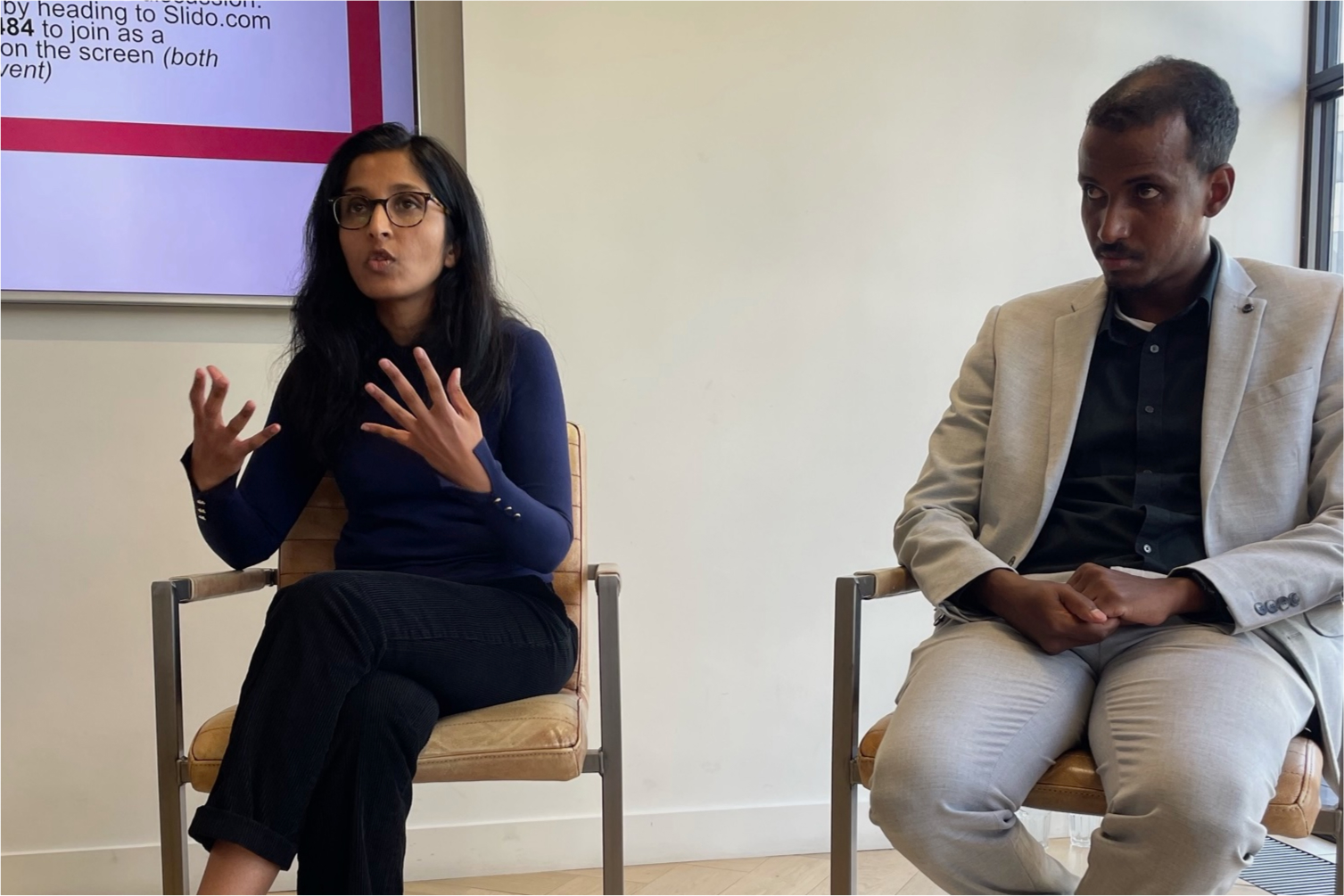This week, we’re marking the 12th annual Global Accessibility Awareness Day, a day to shine a light on the importance of accessible and inclusive design - something that’s been at the heart of our design DNA for many years.
But for those businesses and designers relatively new to digital accessibility, where do you start? What are the barriers to overcome and why should you care? These were just a few of the talking points at the recent BIMA panel discussion we chaired at the Tug agency offices in London’s Shoreditch.
Entitled ‘Digital Design for People with Physical Disabilities’, the panel was hosted by our Chief Commercial Officer Matt Gibson and our Lead UX Designer, Meera Rao and accessibility specialist, Yahye Siyad, Diversity & Accessibility Lead, and Paul Bepey, Senior Accessibility Consultant at Deloitte Digital and. Both Paul and Yahye are registered blind.
Framing the discussion, Matt shared that 96% of the top one million web homepages still fail to conform with WCAG accessibility principles, while 16% of the global population live with some form of significant disability - potentially more than 1.5bn people being excluded from services and products. Yet, despite this, the panel all agreed that accessibility is simply treated as an “afterthought”, “bolt-on” and a “step in a checklist”.
Often, mere compliance with accessibility guidelines like WCAG is the main goal, as Paul explained:
“Some organisations will run automated tests like WAVE or other apps which will potentially not flag up any compliance errors because everything has been tagged – as required - somewhere in the code. But do those labels and tags actually make any sense to a disabled user or have you just passed something that merely has a general tag in a label, or even in fact an incorrect label?
“So what weighting does accessibility really have in the business, who owns it? What’s the cultural measure versus the compliance measure to show how seriously the organisation takes accessibility. If it’s not embedded into your culture then, I’m sorry to say, it really isn’t going to happen. We need a whole mindset shift where people are taking it seriously and talking about it as part of their day to day working practice.”

Panellists Matt, Paul, Meera and Yahye deep in discussion.
Culture, and knowing where to start when it comes to embedding the right culture, is one of the biggest barriers to implementing accessibility in practice, as Meera has seen in her experience as a designer:
“There’s such a fragmented understanding of what accessibility is and because many business teams work in silos each team’s understanding is quite different. So, developers talk about tech accessibility and the check boxes of WCAG and code changes they need to make. Then, designers will talk about something else like usability. And the leadership team talk about overall strategy. It’s all extremely fragmented and stops them from getting started. Ownership, structure, processes and assigned budget, that’s what businesses are built on and if accessibility doesn’t talk the same language and become embedded in people’s working processes it’s hard to get started.”
Yahye added that in most organisations the intention is well-placed and genuine to embrace inclusivity and accessibility but what stops them is the issue of accountability and when it’s seen as an ‘extra add-on’, commenting:
“It’s like I’ve made my pizza, but maybe I’m going to add in pineapple or maybe not, it’s an optional ingredient. If accessibility is viewed as the extra pineapple – and it too often is - we have a problem.
“It needs to be just part of ‘what we do’ and in order to be part of ‘what we do’ there needs to be accountability. So, maybe you start with a focus group, then you move to something more formal and then have a budget and someone to lead on progress. But unless you formalise it and create accountability internally it will always be the extra pineapple. Until that changes, we’re not going to get too far.”

The panellists received some interesting questions from the audience.
As part of best intentions within businesses, an audience question was raised about the use of overlay tools, automated solutions used on websites to ‘fix’ their accessibility challenges. It seems like by using overlays, an organisation is taking the right steps towards accessibility, but from a user’s perspective, are overlays helpful?
Paul said:
“I really don’t agree with overlays. They are not inclusive; if anything they are exclusive – they exclude people unless you are using that specific platform or can ensure any assistive tech like screen readers or eye-tracking systems is compatible. On paper it looks really good, but the downside is it’s extremely costly to keep updating. You end up with a two-tier user system where you have people not using assistive technology having this amazing experience. But then as soon as an update is made where you need codes rewritten and the whole thing revisited, you aren’t able to use the product and it just creates frustration.”
Yahye added:
“Overlays is like trying to use Google translation for translating a legal document. You’re going to get some percentage in there but is it going to be proper to meet the purpose? Definitely not.”
For Meera, as a lead UX designer working across multiple digital experiences for clients, there is no shortcut to accessibility: diverse, inclusive user research, empathy and standard design principles are key to providing accessible services for your customers:
“Accessible design is good design. You don’t need to create something completely bespoke: there are standard principles to work from like leaving lots of space, making sure content is easy to understand, avoiding long scrolls and buttons are easy to use. This helps everyone. The foundations of accessible design are really based on good design."
Words that we aim to live by and to champion through all our work. For insights into how to design for people with non-visible and cognitive disabilities, do register now for our free webinar.
To also find out what the future holds for the future of digital accessibility standards, read our article about the latest draft of WCAG 3.0.

